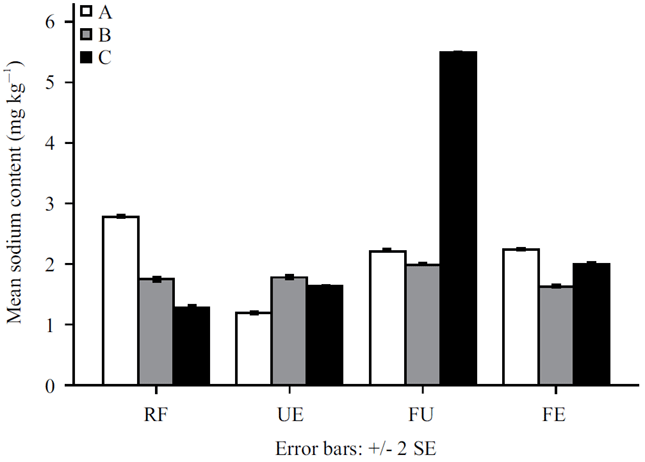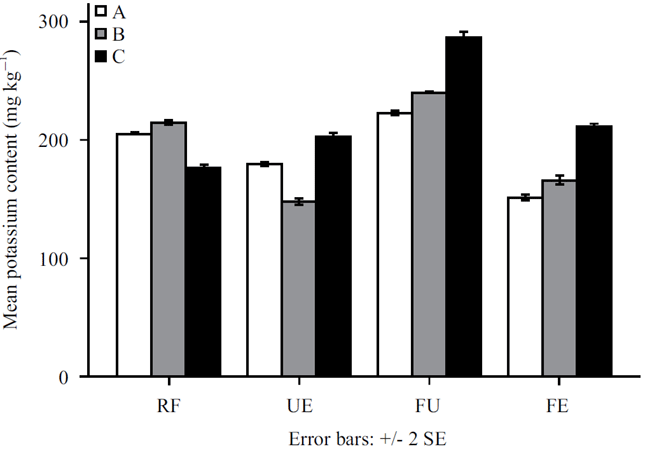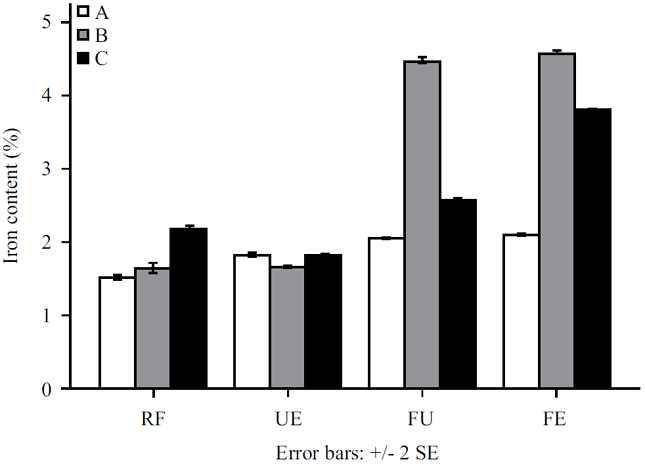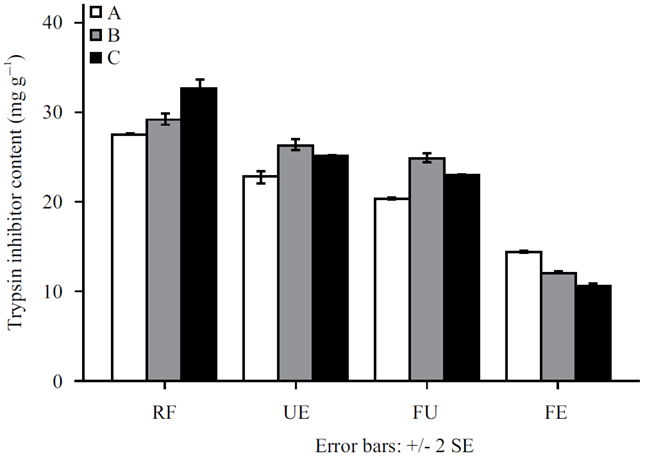Effects of Fermentation and Extrusion on the Mineral and Antinutrient Composition of Plantain-Cowpea Flour Blends
| Received 01 Mar, 2020 |
Accepted 15 Jun, 2020 |
Published 15 Nov, 2020 |
Background and Objective: The presence of antinutrients has been associated with the unavailability of minerals in food, therefore several types of research have been done to reduce or eliminate antinutrients in food. This study was carried out to investigate the effect of fermentation and extrusion on the mineral and antinutrient composition of plantain and cowpea blends. Materials and Methods: Unripe plantain (Musa paradisiaca) and cowpea (Vigna ungiculata) flours were mixed in varying ratios of 100:0, 80:20 and 60:40. These flour blends were fermented naturally at room temperature and further extruded using a laboratory extruder. The mineral and antinutrient compositions were determined using standard methods. Results: The result of the mineral composition revealed that there was no significant difference in sodium content except the fermented unextruded (60:40) blend. Fermented unextruded blends had the highest potassium, calcium and magnesium contents while iron content was highest in the fermented extruded blends. All the antinutrients including phytate, oxalate, tannin, phenol and trypsin inhibitor were greatly decreased by fermentation and extrusion. Conclusion: The research revealed that fermentation and extrusion reduced antinutrients significantly, leading to an increase in the mineral contents of the food blends.
INTRODUCTION
Legumes such as cowpea have been underutilized because of the presence of antinutritional factors such as trypsin inhibitors, phytic acid, flatulence factors, tannin, phenols and lectins so the need for prolonged cooking arouses. These factors negatively affect the nutritive value of cowpea through direct and indirect reactions by binding with nutrients, making them unavailable. Antinutrients are natural compounds in food that are capable of precipitating deleterious effects in man and animals. These compounds are capable of reducing nutrient utilization and or food intake.
Consumption of raw or under- processed legumes leads to nausea, vomiting, and diarrhea. Phytates are the principal storage form of phosphorus and are particularly abundant in legumes and cereals. These chelate divalent cations such as calcium, magnesium, zinc and iron, thereby reducing their bioavailability1. Tannins have been reported to occur in an appreciable amount in legumes. The seed coat of legumes has largely been associated with tannin content. They tend to form weak complexes with proteins, carbohydrates and vitamins. Tannins can cross-link with proteins by reacting with lysine, threonine and tyrosine, thereby making them unavailable during digestion. Oxalate occurs in many plants where it is synthesized by the incomplete oxidation of carbohydrates. In the body, oxalic acid combines with metallic ions such as calcium (Ca2+) and iron (II) (Fe2+) to form crystals of the corresponding oxalates which are then excreted in urine as minute crystals. These oxalates can form larger kidney stones that can obstruct the kidney tubules2.
Phenolic compounds are ubiquitous in plants due to their antioxidant properties. They serve as defense mechanisms for plants and are responsible for some antimicrobial properties of some plants. However, phenolic compounds have been implicated in influencing the functional, nutritional and sensory properties of foods with which they are associated3. Trypsin is an enzyme secreted in mammals (humans inclusive) by the pancreas. It plays an important role in the digestion of protein. It helps to break down protein into smaller components that are then susceptible to assimilation in the intestine. Trypsin inhibitors are low molecular proteins formed by joining identical small size peptide chains. Osagie4 noted that trypsin inhibitors have a molecular weight of 20,000-25,000 with relatively few disulfide bonds. Trypsin inhibitors are growth inhibitors which can produce serious gastric distress, reduced protein digestion and chronic deficiencies in amino acid uptake. Antinutrients in foods can be removed by soaking, boiling, pressure cooking, fermentation, roasting as well as extrusion5,6. Nnam and Obiakor7 reported a decrease in antinutrients during the fermentation of baobab seeds and rice grains. Antinutrient reduction and subsequent increment in extractable minerals with fermentation period were also reported in a study on the effect of fermentation on antinutrients and total and extractable minerals of high and low phytate corn genotypes8.
Simple processing techniques can significantly reduce the level of ant nutritional factors in food. The removal of undesirable components is essential to improve the nutritional quality of legumes and staple foods. This would lead to the full utilization of these food crops. This study was carried out to determine the effect of fermentation and extrusion on the mineral and antinutrient contents of plantain-cowpea blends.
MATERIALS AND METHODS
Study area: The study was carried out at the Microbiology Department, Laboratory of the Federal University of Technology, Akure, Nigeria between March 2015 and December 2015.
Collection of samples: Green matured plantain and cowpea seeds used for this study were gotten from Akure main market, Ondo State Nigeria. The plantain and cowpea seeds were cleaned and processed into flour as described by the method of Ojokoh and Fagbemi9. The flours were kept in airtight containers.
Formation of blends: The unripe plantain and cowpea flours were mixed in various proportions as follows: Sample A: 100 g Unripe plantain flour +0 g cowpea flour. Sample B: 80 g Unripe plantain flour +20 g cowpea flour. Sample C: 60 g Unripe plantain flour +40 g cowpea flour.
Fermentation and extrusion of flour blends: A semi-solid fermentation technique was employed. A batch of the flour blends was fermented for 72 hrs after which they were dried in an oven at 60°C for 24 hrs. Fermented and unfermented blends were hydrated and extruded following the method described by Ojokoh and Fagbemi9. The fermented samples were also extruded. All the extrudates were air-dried for 12 hrs after which they were stored in airtight containers.
Determination of mineral composition: One gram of each sample was weighed into a crucible and transferred into muffle furnace pre-set at 550°C for 120 min. The ashed sample was distilled with 10 mL of 20% nitric acid, placed on the hot plate at 30°C for 1 h. The content was filtered into a 100 mL standard flask and made up to volume with distilled water. The analysis was done in triplicates. The concentration of the mineral content (potassium, calcium, magnesium, zinc, sodium and iron) was measured using Atomic Absorption Spectrophotometer (GBC Scientific Equipment Pty. Ltd.). The mineral composition of the samples was determined using the method described by AOAC10.
Determination of antinutrients: The phytate content in each sample was determined using the modified method of Haug and Lantizsch11. Total phenolic content in the samples was determined by colorimetric assay using Folin-Ciocalteu reagent12. The Arntified et al.13 methods were employed in the determination of trypsin inhibitor. Tannin content was determined by the titrimetric method as described by Khasnabis et al.14. The determination of oxalate was done as described by Adeniyi et al.15.
RESULTS
Mineral composition of the fermented and extruded flour blends: The changes in the sodium content of the blends are represented in Fig. 1. Unfermented extruded blends had the lowest sodium content with values ranging from 1.21±0.02. Fermented unextruded blends had the highest sodium content with values ranging from 2.25±0.01 to 5.50±0.05. The sodium content of raw blends ranged from 1.25±0.08 to 2.80±0.05. The sodium content of fermented extruded blends ranged from 1.64±0.01 to 2.25±0.04.
The potassium content of the blends is shown in Fig. 2. There was a significant difference (p<0.05) between all the samples. Potassium content was highest in fermented extruded blends with values ranging from 223.00±0.01 to 185.00±0.05. Unfermented extruded blends exhibited the lowest potassium content with values ranging from 147.00±0.01 to 203.00±0.12.
The calcium content of plantain- cowpea blends is shown in Fig. 3. There was no significant difference (p<0.05) between samples A and B (6.05±0.01 and 6.10±0.01) of the raw blends but sample C exhibited significant difference (p<0.05) of 10.00±0.05. Unfermented extruded blends recorded a significant difference (p<0.05) among all the samples.
There was also a significant difference (p<0.05) in fermented unextruded blends. Fermented extruded blends exhibited no significant difference (p<0.05) among all the samples.
The magnesium content of the samples is shown in Fig. 4. There was a significant difference between the magnesium content of all the samples. Raw blends had magnesium content ranging from 8.40±0.05 to 26±0.01. Unfermented extruded blends had values ranging from 8.40±0.10 to 10.80±0.07.
Fermented unextruded blends had values ranging from 24.00±0.02 to 32.40±0.05. Fermented extruded blends have values ranging from 6.00±0.01 to 10.70±0.20.
The iron content of the blends is shown in Fig. 5. Sample A and C of the unfermented extruded blends had no significant difference (p<0.05) but sample C had a significant difference. There was a significant difference in the fermented unextruded and fermented extruded samples. Fermented extruded blends had the highest iron content with values ranging from 2.11±0.05 to 4.60±0.01.
The zinc content of plantain- cowpea blends is shown in Fig. 6. Raw blends had values ranging from 0.03±0.01 to 0.21. The zinc content of the unfermented extruded blends ranged from 0.04±0.02 to 0.22±0.05. Fermented unextruded blends had values ranging from 0.07±0.01 to 0.23±0.01. Fermented extruded blends had values ranging from 0.06±0.01 to 0.18±0.02.
Effect of fermentation and extrusion on the antinutrient composition of plantain- cowpea blends: Changes in the antinutrient composition of the samples are presented in Table 1. There was a significant difference (p<0.05) in the phytate content of the blends. The raw blends had the highest phytate content with values ranging from 14.67±0.08 to 20.86±0.08 for samples A to C. Fermented extruded blends had the least phytate content with values ranging from 12.10±0.02 to 15.35±0.01 for samples A to C.
Table 1: Changes in anti- nutrient composition of plantain- cowpea blends (mg g–1) |
||||
| Sample | Phytate | Oxalate | Tannin | Phenol |
| UUA | 14.67±0.08d | 2.07±0.04d | 0.21±0.01d | 0.53±0.01d |
| UUB | 18.61±0.20i | 2.43±0.10e | 0.25±0.03c | 0.63±0.02f |
| UUC | 20.86±0.08j | 4.68±0.08h | 0.52±0.01f | 0.78±0.03h |
| UEA | 14.01±0.04c | 2.07±0.02b | 0.19±0.01b | 0.50±0.01cd |
| UEB | 17.01±0.20g | 2.39±0.12de | 0.21±0.02bc | 0.48±0.02bc |
| UEC | 16.35±0.06f | 4.14±0.11g | 0.41±0.03e | 0.75±0.01gh |
| FUA | 14.21±0.10c | 2.00±0.04ab | 0.20±0.03b | 0.52±0.01d |
| FUB | 17.79±0.06h | 2.40±0.15de | 0.21±0.02bc | 0.59±0.02e |
| FUC | 15.01±0.08d | 3.86±0.01f | 0.31±0.03d | 0.72±0.01g |
| FEA | 12.10±0.02a | 1.86±0.06a | 0.14±0.02a | 0.35±0.02a |
| FEB | 15.35±0.01e | 2.12±0.13bc | 0.19±0.02b | 0.41±0.03b |
| FEC | 13.53±0.16b | 2.25±0.01cd | 0.30±0.03d | 0.52±0.02d |
Data are represented as mean±standard error (n = 3), Values with the same superscript letter(s) along the same column are not significantly different (p<0.05). A: 100 g plantain flour, B: 80 and 20 g plantain: cowpea blend, C: 60 and 40 g plantain: cowpea blend, RF: Raw flour samples, UE: Unfermented extruded blend samples, FU: Fermented unextruded samples, FE: Fermented extruded samples |
||||
Raw blends had the highest oxalate content (2.07±0.04 to 4.68±0.08). Oxalate content significantly (p<0.05) reduced in the fermented extruded blends, having values ranging from 1.86±0.06 to 2.25±0.01. There was a slight decrease in the oxalate content of unfermented extruded (2.07±0.02 to 4.14±0.11) and fermented unextruded blends (2.00±0.04 to 3.86±0.01).
There was no significant difference in the tannin content of samples A and B of the raw blends but sample C exhibited a significant difference. Tannin content was significantly reduced in fermented extruded blends with values ranging from 0.14±0.02 to 0.30±0.03.
There was a significant difference between the phenol content of all the blends. Fermented extruded blends had the lowest phenol content with values ranging from 0.35±0.02 to 0.52±0.02.
Variations in the trypsin inhibitor content of plantain- cowpea blends are shown in Fig. 7. There was a significant difference in the trypsin inhibitor content of all the blends.
Raw blends had the highest trypsin inhibitor content with values ranging from 27.42±0.10 to 32.08±0.07 while fermented extruded blends had the lowest values ranging from 10.55±0.32 to 14.38±0.12.
DISCUSSION
The result of the mineral analysis showed that fermentation increased the content of vital elements such as, Iron, Potassium, Calcium, Sodium and Magnesium in all the samples. This observed increase in the mineral composition may be due to the contribution from fermenting microorganisms. This result corresponds with the findings of Oladele and Oshodi16 in the evaluation of the Effect of Fermentation on Some Chemical and Nutritive Properties of Berlandier Nettle Spurge (Jatropha cathartica) and Physic Nut (Jatropha curcas) Seeds. Mbata et al.17 also reported an increase in zinc, calcium, magnesium and iron content of fermented maize and Bambara nut blends. Steve18 also reported an increase in mineral contents of fermented wheat flour.
The results of antinutrient components revealed that extrusion cooking significantly reduced phytate levels. It could be expected that lowering this compound would enhance the bioavailability of minerals such as zinc and iron in the extrudates since phytic acid has been implicated in making these minerals unavailable as reported by Anuonye et al.19. A decrease in phytate content may be partly due to the formation of insoluble complexes between phytate and other components. It could also be due to the heat-labile nature of phytic acid. The effect of fermentation on phytic acid may be due to the activity of enzymes like phytase produced by fermenting micro flora20. The reduction in phytate level of fermented blends could be interpreted as the main reason behind the observed increase in the concentrations of minerals in the fermented samples. Reduction in the phytate content was also reported by Hassan et al.21 when he evaluated the effect of blanching and fermentation on cocoyam.
The level of tannin was significantly reduced in the unfermented extruded blends, fermented unextruded blends as well as fermented extruded blends. Tannins form insoluble complexes with proteins thereby decreasing protein digestibility22. Tannins also decrease palatability, cause damage to the intestinal tract and enhance carcinogenesis23,24. The reduction of tannin in the fermented blends may be as a result of the fact that tannins are polyphenols and all polyphenolic compounds are water-soluble in nature25. Therefore, reduction in tannin content of the fermented blends may be attributed to leaching out of phenols into the fermenting media25. A similar result was also reported by Hassan et al.21.
Oxalate content was significantly reduced (p<0.05) in fermented unextruded and fermented extruded blends. This result could be attributed to the combined effect of various microflora involved during the fermentation process. Oxalate may be present as oxalic acid or as insoluble calcium oxalate which when present in high concentration in the diet may result in the risk of renal calcium absorption4. Hassan et al.21 reported a significant (p<0.05) decrease in the oxalate content of fermented cocoyam samples. There was a decrease in the phenol content of the extrudates and fermented blends. The decrease in the phenol content of extruded blends could be attributed to the high temperature of the extruder. Korus et al.26 attributed the decrease in the phenolic content of beans to high temperatures when he evaluated the effect of extrusion on the phenolic composition and antioxidant activity of dry beans. Altan et al.27 also reported a decrease in the total phenol content of extruded barley. Suazo et al.28 reported that the concentration of phenol reduced with fermentation. Nogueira et al.29 also stated that phenol content in apple juice significantly reduced fermentation.
Generally, there was a reduction in the trypsin inhibitor content of the extrudates and fermented blends. Similar results were reported for trypsin inhibitor activity of extruded soy-potato30, extruded acha-soybean31 and extruded white yam and Bambara nuts32. Nwabueze et al.33 also reported that extrusion cooking resulted in the reduction of trypsin inhibitor in breadfruit based spaghetti. Reduction in trypsin inhibitor in the extrudates could be as a result of its well-established heat-labile nature. Reduction in the trypsin inhibitor content implies that protein digestibility will not be hampered34. The rate at which these antinutrients affect the availability of nutrients by chelating the nutrients and making them unavailable for utilization in the system will be relatively reduced. Since the higher the level of antinutrient, the lower the bioavailability of the nutrient and minerals contained therein.
CONCLUSION
In conclusion, fermentation and extrusion had a high impact on the antinutrients by decreasing significantly, thereby leading to the bioavailability of minerals in the fermented and extruded plantain- cowpea flour blends.
SIGNIFICANCE STATEMENT
This study discovers the synergistic effect of fermentation and extrusion which improved the mineral composition and significantly reduced the antinutrient composition of plantain and cowpea blends. This study will help the researcher to uncover the critical areas of utilizing and consumption of underutilized legumes which can help to reduce malnutrition in developing countries that many researchers were not able to explore. Thus, a new theory on the reduction of legume antinutrients and nutrient enhancement as well as food combinations may be arrived at.
REFERENCES
- Sandberg, A.S., 2002. Bioavilability of minerals in legumes. British J. Nutr., 88: 281-285.
- Coe, F., A. Evan and E. Worcester, 2005. Kidney stone disease. J. Clin. Invest., 115: 2598-2598.
- Muchoki, C.N., P.O. Lamula and J.K. Imungi, 2010. Reduction of nitrates, oxalates and phenols in fermented sloar- dried stored cowpea (Vignaunguiculata L.) leaf vegetables. Afr. J. Food Agric. Nutr. Dev., 10: 4398-4412.
- Osagie, A.U., 1998. Antinutritional Factors. In: Nutritional Quality of Plant Foods, Osagie, A.U. and O.U. Eka (Eds.). Post Harvest Research Unit, University of Benin, Benin, Nigeria, pp: 120-133.
- Khokhars, E. and B.M. Chauham, 1986. Antinutritional factors in Moth bena (Vagina aconitifolia). Varietals differences and effects of methods of domestic processing and cooking. J. Food Sci., 51: 591-594.
- Ojokoh, A.O., M.K. Daramola and O.J. Oluoti, 2013. Effect of fermentation on nutrient and anti-nutrient composition of breadfruit (Treculia africana) and cowpea (Vigna unguiculata) blend flours. Afr. J. Agric. Res., 8: 3566-3570.
- Nnam, N.M. and P.N. Obiakor, 2003. Effect of fermentation on the nutrient and antinutrient composition of Baobab (Adansonia digitata) seeds and rice (Oryza sativa) grains. Ecol. Food Nutr., 42: 265-277.
- Sokrab, A.M., I.A.M. Ahmed and E.E. Babiker, 2014. Effect of fermentation on antinutrients and total and extractable minerals of high and low phytate corn genotypes. J. Food Sci. Technol., 51: 2608-2615.
- Ojokoh, A.O. and A.O. Fagbemi, 2016. Effects of fermentation and extrusion on the proximate and organoleptic properties of cowpea-plantain flour blends. Br. Microbiol. Res., 13: 1-13.
- AOAC., 2012. Official Methods of Analysis. 19th Edn., Association of Official Analytical Chemist, Washington, DC.
- Haug, W. and H.J. Lantzsch, 1983. Sensitive method for the rapid determination of phytate in cereals and cereal products. J. Food Sci. Agric., 34: 1423-1426.
- Shaver, L.A., S.H. Leung, A. Puderbaugh and S.A. Angel, 2011. Two methods of determining total phenolic content of foods and juices in a General, Organic and Biological (GOB) chemistry lab. J. Chem. Educ., 88: 492-495.
- Arntifield, S.D., M.A.H. Ismond and E.D. Murray, 1985. The fate of antinutritional factors during the preparation of a fababean protein isolate using a micellization technique. Can. Inst. Food Sci. Tech. J., 18: 137-143.
- Khasnabis, J., C. Rai and A. Roy, 2015. Determination of tannin content by titrimetric method from different types of tea. J. Chem. Pharm. Res., 7: 238-241.
- Adeniyi, S.A., C.L. Orjiekwe and J.E. Ehiagbonare, 2009. Determination of alkaloids and oxalates in some selected food samples in Nigeria. Afr. J. Biotechnol., 8: 110-112.
- Oladele, E.P. and A.A. Oshodi, 2008. Effect of fermentation on some chemical and nutritive properties of berlandier nettle spurge (Jatropha cathartica) and physic nut (Jatropha curcas) seeds. Pak. J. Nutr., 7: 292-296.
- Mbata, T.I., M.J. Ikenebomeh and S. Ezeibe, 2009. Evaluation of mineral content and functional properties of fermented maize (Generic and specific) flour blended with bambara groundnut (Vigna subterranean L.). Afr. J. Food Sci., 3: 107-112.
- Steve, I.O., 2012. Influence of germination and fermentation on chemical composition, protein quality and physical properties of wheat flour (Triticum aestivum). J. Cereals Oil Seeds, 3: 35-47.
- Anuonye, J.C., J.O. Onuh, E. Egwim and O.S. Adeyemo, 2010. Nutrient and antinutrient composition of extruded acha/soybean blends. J. Food Process., 34: 680-691.
- Makinde, F.M., R. Akinoso and A.O. Adepoju, 2013. Effect of fermentation containers on the chemical composition of fermented sesame (Sesamum indicum L.) seeds. Afr. J. Food Agric. Nutr. Dev., 13: 7122-7137.
- Hassan, G.F., L. Yusuf, T.T. Adebolu and A.K. Onifade, 2015. Effect of fermentation on mineral and anti-nutritional composition of cocoyam (Colocasia esculenta Linn). Sky J. Food Sci., 4: 042-049.
- Uzoechina, O.B., 2007. Evaluation of the effect of processing techniques on the nutrient and antinutrient contents of Pigeon Pea (Cajanus cajan) seeds flours. J. Food Sci., 28: 76-77.
- Makkar, H.P.S. and K. Becker, 1996. Effect of pH, temperature and time on inactivation of tannins and possible implications in detannification studies. J. Agric. Food Chem., 44: 1291-1295.
- Anuonye, J.C., A.A. Jigam and G.M. Ndaceko, 2012. Effects of extrusion-cooking on the nutrient and anti-nutrient composition of pigeon pea and unripe plantain blends. J. Appl. Pharm. Sci., 2: 158-162.
- Udensi, E.A., F.C. Ekwu and J.N. Isinguzo, 2007. Antinutrient factors of vegetable cowpea (sesquipedalis) seeds during thermal processing. Pak. J. Nutr., 6: 194-197.
- Korus, J., D. Gumul and K. Czechowska, 2007. Effect of extrusion on the phenolic composition and antioxidant activity of dry beans of Phaseolus vulgaris L. Food Technol. Biotechnol., 45: 139-146.
- Altan, A., K.L. McCarthy and M. Maskan, 2009. Effect of extrusion process on antioxidant activity, total phenolics and β‐glucan content of extrudates developed from barley‐fruit and vegetable by‐products. Int. J. Food Sci. Technol., 44: 1263-1271.
- Suazo, Y., G. Davidov-Pardo and I. Arozarena, 2014. Effect of fermentation and roasting on the phenolic concentration and antioxidant activity of cocoa from Nicaragua. J. Food Qual., 37: 50-56.
- Nogueira, A., S. Guyot, N. Marnet, J.M. Lequéré, J.F. Drilleau and G. Wosiacki, 2008. Effect of alcoholic fermentation in the content of phenolic compounds in cider processing. Braz. Arch. Biol. Technol., 51: 1025-1032.
- Iwe, M.O. and P.O. Ngoddy, 2000. Effect of extrusion on trypsin inhibitor contents of soy-sweet potato mixtures. J. Food Proces. Preserv., 24: 453-463.
- Anuonye, J.C., G.I.O. Badifu, C.U. Inyang, M.A. Akpapunam, C.U. Odumudu and V.I. Mbajika, 2007. Protein dispersibility index and trypsin inhibitor activity of extruded blends of acha/aoybean: A response surface analysis. Am. J. Food Technol., 2: 502-511.
- Oluwole, O.B., A.A. Olapade, S.O. Awonorin and F.O. Henshaw, 2013. Physicochemical properties of extrudates from white yam and bambara nut blends. Int. Agrophys., 27: 69-74.
- Nwabueze, T.U., M.O. Iwe and E.N.T. Akobundu, 2007. Unit operations and analyses for african breadfruit based spaghetti-type products at extreme process combinations. J. Food Technol., 5: 87-94.
- Iorgyer, M.I., I.A. Adeka, N.D. Ikondo and J.J. Okoh, 2009. The impact of boiling periods on the proximate composition and level of some anti nutritional factors in pigeon pea (Cajanus cajan) seeds. PAT., 5: 92-102.
How to Cite this paper?
APA-7 Style
Omojokun,
A., Jokoh,
A. (2020). Effects of Fermentation and Extrusion on the Mineral and Antinutrient Composition of Plantain-Cowpea Flour Blends . Asian Journal of Emerging Research, 2(4), 190-199. https://doi.org/10.3923/AJERPK.2020.190.199
ACS Style
Omojokun,
A.; Jokoh,
A. Effects of Fermentation and Extrusion on the Mineral and Antinutrient Composition of Plantain-Cowpea Flour Blends . Asian J. Emerg. Res 2020, 2, 190-199. https://doi.org/10.3923/AJERPK.2020.190.199
AMA Style
Omojokun
A, Jokoh
A. Effects of Fermentation and Extrusion on the Mineral and Antinutrient Composition of Plantain-Cowpea Flour Blends . Asian Journal of Emerging Research. 2020; 2(4): 190-199. https://doi.org/10.3923/AJERPK.2020.190.199
Chicago/Turabian Style
Omojokun, A.O., and A.O. Jokoh.
2020. "Effects of Fermentation and Extrusion on the Mineral and Antinutrient Composition of Plantain-Cowpea Flour Blends " Asian Journal of Emerging Research 2, no. 4: 190-199. https://doi.org/10.3923/AJERPK.2020.190.199

This work is licensed under a Creative Commons Attribution 4.0 International License.










